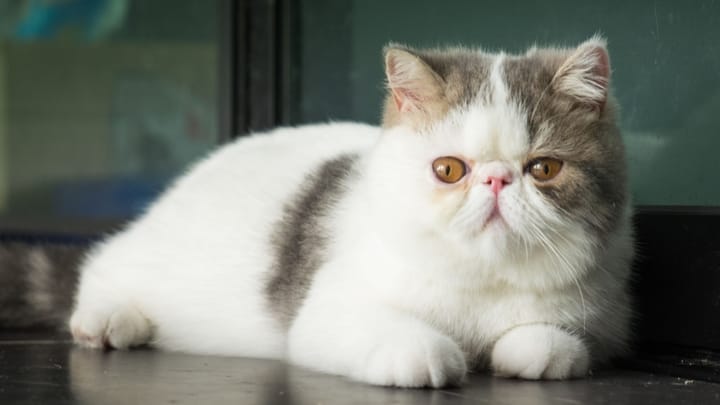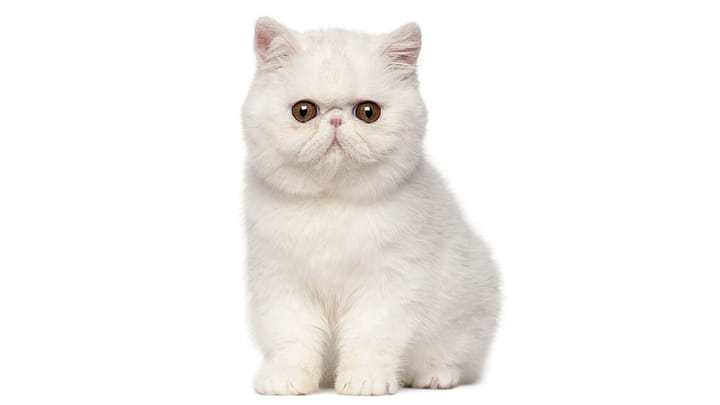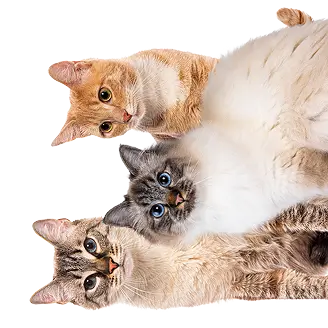Exotic shorthair
Other names : Exotic, Persian shorthair


The Exotic, or Exotic Shorthair, has all the characteristics of a teddy bear. Their dense hair is irresistible to the touch, they look like a ball and their attitude is gentle and quiet, with a touch of infantile madness. They adapt to all kinds of home, with a preference for cozy apartments that are full of toys. The perfect cat for lovers of Persians who do not want to have to maintain long fur!
|
Life expectancy |
The Exotic shorthair has a life expectancy of between 12 and 15 years |
|
Temperament |
|
|
Adult size |
Female
Between 12 and 14 in
Male
Between 12 and 14 in
|
|
Adult weight |
Female
Between 7 and 11 lb
Male
Between 7 and 13 lb
|
|
Coat colour
All the same colours that are found in Persians are found in the Exotic shorthair. |
Black Brown White Red Cream Blue |
|
Type of coat
Short |
Short |
|
Eye colour
Copper or orange, but this depends on the colour of the coat. They can also be blue, hazel or green. |
Blue
Green
Brown
|
|
Purchase price |
The Exotic shorthair costs between £300 and £600 |
The short hair gene is a dominant gene. The Exotic is homozygous or heterozygous. This means that it can happen that some offspring will have long hair! These individuals will be recognised as long-haired Exotics by some federations, while for others they will be Persians.
Also, it is essential for the breed to keep Persian blood, otherwise, the coat changes over time and becomes less dense.
More details about the Exotic shorthair
Exotic shorthair: Origins and history
The Exotic was born in the fifties, in the United States, following attempts to cross short-haired cats with a Persian, to improve the existing breed. The unsuccessful results, from a certain point of view, became the foundation for the creation of this new breed.
The first cross was the American Shorthair with a Persian Silver. The goal was to get a silver-haired American Shorthair, but unfortunately the offspring did not meet the standards of the latter. Jane Martinke discovered these kittens and proposed to establish a new breed. First called "Sterling", it was renamed Exotic Shorthair to expand the possible coat colours.
Meanwhile, Carolyn Bussey, owner of the New Dawn Cattery, crossed one of her cats with a Burmese in order to obtain a brown Persian. The kittens that followed, convinced the breeder to design a short-haired Persian. Her work contributed enormously to the breed after being officially recognised.
The Russian Blue was used for the fluffy appearance of the fur. Perhaps other breeds also contributed to the creation of the Exotic, but since the short hair gene is dominant and the goal was to create a short-haired Persian, the long-haired Persian was almost exclusively used, for the development and maintenance of a good genetic pool.
Physical characteristics of the Exotic shorthair
Like the Persian, the Exotic is evolving in appearance because the standards of the breed are being more and more pushed to the extreme. The main criterion? Roundness! Of cobby type, the body forms a short and rounded rectangle. They are muscular, with a robust frame and their weight may surprise you. Their legs are short and powerful. The tail is shorter than average, but in proportion with the body and very dense. The head is round, ears are small, round and quite low on the skull. Their eyes are very round and shiny. The nose is wide, but very short with a very pronounced stop, which makes their profile almost flat. Finally, they are covered with a dense coat, short and very thick, similar to that of a soft toy, which accentuates their rounded look even more!
Exotic shorthair: Characteristics
Exotic shorthair: Behaviour
Breed compatibility Exotic shorthair
Exotic shorthair: Purchase price
On average, the price of an Exotic kitten ranges between £300 and £600. The sex, the age, the pedigree, etc ... are factors that cause variations in the price. It will cost around £25 / month to provide for their needs.
Exotic shorthair: Shedding
Heavy !
Even if they tend to lose less fur than the long-haired version, the Exotic Shorthair still loses quite a lot of hair. Due to their thick coat and undercoat.
Exotic shorthair: Grooming
Often called the "Persian for lazy people", their maintenance is minimal: simply comb their hair once a week. Only their eyes need to be wiped regularly, especially if they tend to run, because moisture in the folds of facial skin can quickly lead to infection.
Exotic shorthair: Health
The Exotic tends to live for 12 to 15 years on average.
Little more robust than their cousin, they prefer to live in a controlled environment such as an apartment.
Like all cobby type cats, the Exotic is inclined to put on too much weight.
- Polycystic kidney disease: autosomal dominant genetic kidney disease, it is very common in Persians. The symptoms appear around the age of 7. A screening test is available. The only way to stop the disease is to mate only healthy individuals
- Hypertrophic cardiomyopathy: cardiac pathology that causes heart failure
- Peritoneal-pericardial hernia: the passage of abdominal organs in the pericardium, the cavity where the heart is located
- Progressive atrophy of the retina: hereditary, it causes a loss of vision in the first months of life. The gene (s) responsible are currently being researched in order to develop a genetic test
- Corneal sequestra: pathology of the cornea specific to cats, especially Persians
- Cystitis and bladder stones: diseases of the bladder
- The portosystemic shunt: vascular pathology decreasing the blood circulation of the liver. Its symptoms are related to toxins that accumulate in the blood instead of being normally metabolised to the liver
- Polycystic liver disease: associated with polycystic kidney disease
- Skin diseases: Idiopathic facial dermatitis, dermatophytosis (ringworm), primary seborrhoea, certain tumors ...
- Chédiak-Higashi syndrome: an illness that is almost specific to the Persian Blue Smoke which causes a lack of accumulation of melanin in lysosomes and a malfunction of platelets and certain white blood cells
- Nasopharyngeal polyps: benign tumors that can be found in the nose, sinuses, ears, pharynx ...
- Cryptorchidism: testicles that do not descend to the scrotum during the maturation of the sex organs
- Periodontal diseases: The much shorter jaw of the brachycephalic breeds causes differences in the grip and chewing of food as well as in the position of the teeth (the number of teeth is the same as other cats) and scale problems, gingivitis and sometimes even digestion issues
- Respiratory problems related to their brachycephalic conformation
- And all the other pathologies of domestic cats.
They reach sexual maturity a bit later than other breeds. The number of kittens per litter is slightly lower too. The risk of complications at birth is higher, due to the large size of the kitten’s heads.
Authorised crosses, besides amongst the breed, are only allowed with the Persian.







